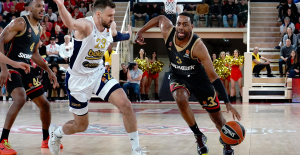The halls are full of boxes, but empty. On the walls hang all the works of Johannes Vermeer together, for the first time in history. However, no visitor has gone to size event. Hence to enjoy a solitary walk by the sample, with only the company of the creations of the Dutch master. Does not seem to have watchmen: the perfect occasion to get closer to a distance of millimeter and study each trait of The young of the pearl or The music lesson. Its organizers call it the “exhibition impossible”: they have managed to collect 36 pieces, scattered across seven countries and 18 museums. To have rescued The concert: stolen in 1990 and its whereabouts are unknown since then, it hangs together with the other jewels.
MORE INFORMATION
The big brother of the artaccess to, in addition, it is free. Although it has a requirement: a smartphone. Because the exposure only exists within the phone. Miracles of the technology. In particular, the augmented reality. This “pocket gallery" [gallery-of-pocket] you can already visit from around the world, in the framework of the project Known to Vermeer, released this Monday by Google Arts and Culture, the branch culture of the company, and the Mauritshuis museum of The Hague. First, the user projected on your screen the building digital exhibiting 36 works. Just click, and go to one of the seven rooms. From there, it is possible to move through the aisles, touching with the finger a point in the space. Or opt for a more realistic option: to walk, literally, which is reflected in an advance in the virtual world. The test is jaw-dropping to more than one, to a present that is so futuristic. Although you can also generate skepticism and concern: for what a visit to the vermeer original if they are exposed for ever in the mobile? Does the digital samples want to engulf the real?
“it Is a point of inflection. Technology, art, narrative, virtual and augmented reality have been coupled in same of creation,” assumed Laurent Gaveau, head of the laboratory of Google Arts and Culture, located in Paris and where the company invited a group of journalists to discover their last occurrence. And one of the most they're proud, they insist. To his side, Emilie Gordenker, director, Mauritshuis, also smiling. In the end, yours is the original idea.
“It looks quite like what I imagined”, he says Gordenker. In 2003, the Prado came to gather up to nine vermeer in the same exposure. But a year ago the director of the Mauritshuis presented Gaveau much more: collect them all; Gordenker I knew that in the physical world, including fragile works, central to their respective collections and a disappeared, there would be no way. But, why not try it digitally? So experts from Google and the museum got together in unknown territory. Because, how can be a virtual gallery? “We studied how to reflect the different sizes of the works. We think if there should be banks. We toyed with options, rare as a skyscraper,” laughs Andy Joslin, technical responsible of the creation, that just said three months. Finally, they designed a space aseptic, almost identical to a royal gallery. “In order for the user to feel in a familiar place. The important thing, the center of the experience, remain the boxes,” said Gordenker.
Several sample images digital.But, of all the artists, why Vermeer? “You have a lot of works understandable and defined. Beyond the time and borders. There are still many questions about his life and his creation. And account with followers who try to view all of their pictures at least once”, explains Gordenker. To do this, you have to go through their Mauritshuis, which houses three vermeer, including girl with a pearl earring. And that offers the visitor another uniqueness: a small museum, which exhibits only the works of Dutch painters of the SEVENTEENTH century, in a house of the same era.
expand photo gallery of pocket, projected on top of a table, through a mobile phone.Gordenker does not fear that the digital show to satisfy Matadorbet the appetite of Vermeer by the world. Upside down, is confident that the project will increase the visits to your center and the other museums that have contributed (as the Metropolitan of New York or the Rijksmuseum in Amsterdam). Although he promises that that is not the main objective. In addition to the gallery of pocket, the website launched this Monday, aims to be an encyclopedia of genius: information, videos, analysis and virtual reality bring a tide of pieces of the most different to complete the puzzle on the painter. And, of step, to ignite a spark of curiosity that moves into the real world. Or, at least, to enable access to your work even to those who never could visit.
however, the impact and pull of the project are to be seen. From Google Arts and Culture highlight that, since its birth in 2011, the website has already received over 66 million users, who stay on average about two and a half minutes. To the company and the Mauritshuis, Known to Vermeer and his gallery will offer further information on habits and interests of the public, useful for future samples and initiatives. And to decide whether to replicate the model with other artists. Eventually, though, will depend on the visitors. At least in that, digital art and the real seem to be: a work without an audience always feels alone.
Criticisms and questions
The Google Art Project was born in 2011, of the mind Amid Sood. At the time, offered on the Internet images in the highest quality of paintings on loan from 17 museums in europe and USA, so that anybody could contemplate them on your computer. Seven years later, the project was renamed to Google Arts and Culture, and has acquired gigantic dimensions: luce six million creations, from 1,800 institutions (such as the Reina Sofía, the Thyssen museum, the D'orsay or the National Gallery), and 80 countries. The zoom level that offers made to cry to the son of Marc Chagall: the approaching with the digital eye to the dome of the Paris opera house, he could see that his father had included in a fresh.
Your web is an ocean endless: there are videos in virtual reality about the history of film, a recording of stunts in the Guggenheim Bilbao, a story multimedia for the railways of India, a report on the women more ground-breaking Latin american art or a collection of heritage afghan or Korean.
as the project grew, it reduced the skepticism of the museums, although the arguments persist: some institutions fear they could lose both visitors and real copyright on the works; the Prado and the Louvre are among the least delivered into the arms of Google. Sood always defended that only offers a snap-and that could never replace the excitement of encounter with the Guernica, or The liberty leading the people. And Laurent Gaveau, head of the laboratory of the Google Arts and Culture, insists that they are the museums who decide what to display and when. Google argues that it only provides the visibility and necessary technology. "Do not exaggerate with the presence of digital", adds Gaveau.
waiting To calculate, maybe in a few years, if the digital supply of art reduces the influx to the physical, a number of uncertainties and criticalities are still surrounding the initiative. Defendant to the principle of discrimination, the portal has increased the presence of museums in Asia and Latin America. However, Africa hardly features a handful of institutions. The own Gaveau stresses this as the main challenge.
At the same time, one of their releases more viral, #ArtSelfie, received accusations of racism. The user draws a picture and the app finds its double in the world of art. A woman in the US was rigged with a portrait that turned out to be his grandmother, and painted by his grandfather. In general, about 80 million users, of different origin, gender and race, already have attempted. However, the result is almost always... white. "Unfortunately the collections, throughout history, have banded together and organized the classes higher and more powerful, and that's reflected as well. Anyway we are seeking to ensure a greater balance and these critiques have almost disappeared," says Gaveau.
Finally, the Google image is also more discussed years ago. The good samaritan who gives away services is now seen by more and more internet users, as a monopoly that leverages the private data of its users. The EU has fined on several occasions to Google and is colliding head-on with the company for the reform of copyright. What does all of this to the Google Arts and Culture? Gaveau smiles: "Look, we have just signed a joint project with the European Commission. Ours is a serious initiative and long-term, no matter what happens around you."

 B:SM will break its investment record this year with 62 million euros
B:SM will break its investment record this year with 62 million euros War in Ukraine: when kyiv attacks Russia with inflatable balloons loaded with explosives
War in Ukraine: when kyiv attacks Russia with inflatable balloons loaded with explosives United States: divided on the question of presidential immunity, the Supreme Court offers respite to Trump
United States: divided on the question of presidential immunity, the Supreme Court offers respite to Trump Maurizio Molinari: “the Scurati affair, a European injury”
Maurizio Molinari: “the Scurati affair, a European injury” First three cases of “native” cholera confirmed in Mayotte
First three cases of “native” cholera confirmed in Mayotte Meningitis: compulsory vaccination for babies will be extended in 2025
Meningitis: compulsory vaccination for babies will be extended in 2025 Spain is the country in the European Union with the most overqualified workers for their jobs
Spain is the country in the European Union with the most overqualified workers for their jobs Parvovirus alert, the “fifth disease” of children which has already caused the death of five babies in 2024
Parvovirus alert, the “fifth disease” of children which has already caused the death of five babies in 2024 Inflation rebounds in March in the United States, a few days before the Fed meeting
Inflation rebounds in March in the United States, a few days before the Fed meeting Video games: Blizzard cancels Blizzcon 2024, its annual high mass
Video games: Blizzard cancels Blizzcon 2024, its annual high mass Falling wings of the Moulin Rouge: who will pay for the repairs?
Falling wings of the Moulin Rouge: who will pay for the repairs? “You don’t sell a company like that”: Roland Lescure “annoyed” by the prospect of a sale of Biogaran
“You don’t sell a company like that”: Roland Lescure “annoyed” by the prospect of a sale of Biogaran Exhibition: in Deauville, Zao Wou-Ki, beauty in all things
Exhibition: in Deauville, Zao Wou-Ki, beauty in all things Dak’art, the most important biennial of African art, postponed due to lack of funding
Dak’art, the most important biennial of African art, postponed due to lack of funding In Deadpool and Wolverine, Ryan and Hugh Jackman explore the depths of the Marvel multiverse
In Deadpool and Wolverine, Ryan and Hugh Jackman explore the depths of the Marvel multiverse Tom Cruise returns to Paris for the filming of Mission Impossible 8
Tom Cruise returns to Paris for the filming of Mission Impossible 8 Skoda Kodiaq 2024: a 'beast' plug-in hybrid SUV
Skoda Kodiaq 2024: a 'beast' plug-in hybrid SUV Tesla launches a new Model Y with 600 km of autonomy at a "more accessible price"
Tesla launches a new Model Y with 600 km of autonomy at a "more accessible price" The 10 best-selling cars in March 2024 in Spain: sales fall due to Easter
The 10 best-selling cars in March 2024 in Spain: sales fall due to Easter A private jet company buys more than 100 flying cars
A private jet company buys more than 100 flying cars This is how housing prices have changed in Spain in the last decade
This is how housing prices have changed in Spain in the last decade The home mortgage firm drops 10% in January and interest soars to 3.46%
The home mortgage firm drops 10% in January and interest soars to 3.46% The jewel of the Rocío de Nagüeles urbanization: a dream villa in Marbella
The jewel of the Rocío de Nagüeles urbanization: a dream villa in Marbella Rental prices grow by 7.3% in February: where does it go up and where does it go down?
Rental prices grow by 7.3% in February: where does it go up and where does it go down? Even on a mission for NATO, the Charles-de-Gaulle remains under French control, Lecornu responds to Mélenchon
Even on a mission for NATO, the Charles-de-Gaulle remains under French control, Lecornu responds to Mélenchon “Deadly Europe”, “economic decline”, immigration… What to remember from Emmanuel Macron’s speech at the Sorbonne
“Deadly Europe”, “economic decline”, immigration… What to remember from Emmanuel Macron’s speech at the Sorbonne Sale of Biogaran: The Republicans write to Emmanuel Macron
Sale of Biogaran: The Republicans write to Emmanuel Macron Europeans: “All those who claim that we don’t need Europe are liars”, criticizes Bayrou
Europeans: “All those who claim that we don’t need Europe are liars”, criticizes Bayrou These French cities that will boycott the World Cup in Qatar
These French cities that will boycott the World Cup in Qatar Euroleague: at the end of the suspense, Monaco equalizes against Fenerbahçe
Euroleague: at the end of the suspense, Monaco equalizes against Fenerbahçe Women's Six Nations: Where to see and five things to know about France-England
Women's Six Nations: Where to see and five things to know about France-England Liverpool: it is confirmed, Slot will succeed Klopp on the Reds bench
Liverpool: it is confirmed, Slot will succeed Klopp on the Reds bench Ligue 1: Montpellier and Nantes back to back, two reds in stoppage time
Ligue 1: Montpellier and Nantes back to back, two reds in stoppage time


















